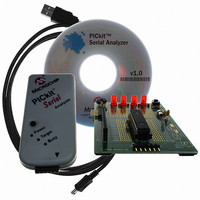DV164122 Microchip Technology, DV164122 Datasheet - Page 129

DV164122
Manufacturer Part Number
DV164122
Description
ANALYZER SRL PICKIT W/DEMO BOARD
Manufacturer
Microchip Technology
Series
PICkit™r
Type
MCUr
Specifications of DV164122
Contents
PICkit™ Serial Analyzer, 28-pin Demo Board, USB Cable, and Software with Documentation CD
Processor To Be Evaluated
PIC16F886
Interface Type
USB
Silicon Manufacturer
Microchip
Kit Application Type
Interface
Application Sub Type
USB
Silicon Family Name
PIC16F
Kit Contents
PICkit Serial Analyzer, Demo Board, USB Cable, Software
Rohs Compliant
Yes
Lead Free Status / RoHS Status
Not applicable / Not applicable
For Use With/related Products
PIC16F886
For Use With
PKSERIAL-SPI1 - BOARD DEMO PICKIT SERIAL SPIPKSERIAL-I2C1 - BOARD DEMO PICKIT SERIAL I2C
Lead Free Status / Rohs Status
Lead free / RoHS Compliant
Other names
Q3260228
Available stocks
Company
Part Number
Manufacturer
Quantity
Price
Company:
Part Number:
DV164122
Manufacturer:
Microchip Technology
Quantity:
135
Company:
Part Number:
DV164122
Manufacturer:
MICROCHIP
Quantity:
12 000
© 2007 Microchip Technology Inc.
11.10.3.2 TAG: SDATA:
TAG commands and data returned from the PICkit Serial Analyzer.
TABLE 11-47:
Those TAGs (above) identified as ‘EVENT’, generally mark the occurrence of LIN bus
activity. As with all other supported PKSA serial protocols, the ‘EVENT’ TAGs are gen-
erated when/as are detected in real time and queued in a circular buffer for transmis-
sion to the HOST. Each TAG can be individually enabled/disabled using the appropriate
configuration bit in the CONTROL BLOCK.
11.10.4 Parameter Detail
11.10.4.1 BAUD
The PKSA BAUD rate is configured by a 2-byte code as detailed in the table(s) below.
Upon initialization, the PKSA is configured with the ‘default’ BAUD specified in the
CONTROL BLOCK (bytes 22 & 23) as documented in the table above. Additionally, the
BAUD rate can be changed in the context of script execution (real time) using the
appropriate script/SCMND TAG. At all times the STATUS BLOCK reflects the currently
active BAUD rate. This BAUD rate applies to all data transmitted by the PKSA.
AUTOBAUD
The PKSA-LIN ‘monitor’ function has the flexibility to auto baud detect and modify the
PKSA hardware configuration to receive ‘messages’ from the LIN bus at the BAUD rate
being transmitted. This ‘flexibility’ must be enabled using the configuration bit in the
CONTROL BLOCK (byte 16 bit 7). The HOST can be apprised of the ‘auto baud’ detect
action through an event marker TAG.
The AUTOBAUD operation depends on receiving a ‘BREAK’ (13 bits of 0s) followed by
a ‘SYNC’ (byte 0x55). Referring to the timing diagram below – the BREAK begins at ‘A’.
At ‘B’ the PKSA expected a STOP bit – the USART interrupts the PKSA (RCIF – receive
interrupt flag) and sets FERR (framing error). The PKSA interprets (1) DATA=0 and (2)
FERR (framing error) as having received a BREAK; therefore, the FERR is automati-
0x80
0x81
0x82
0x83
0x84
0x85
SDATA
TAG /
2
2
2
1
1
3
LEN
LIN _EVENT_BYTE_TX
LIN _EVENT_STATUS_ERR
LIN _EVENT_BREAK_RX
LIN _EVENT_BREAK_TX
LIN_EVENT_BYTE_RX
LIN _EVENT_AUTOBAUD
NAME
BYTE received
0
1
BYTE transmitted
0
1
status error
0
1
BREAK received
0
BREAK transmitted
0
AUTOBAUD event
0
1
2
TAG
data
TAG
data
TAG
error byte
TAG
TAG
TAG
BAUD CODE (LSB)
BAUD CODE (MSB)
DESCRIPTION
DS51647B-page 123












